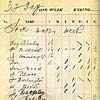 |
|
|||||||||||||||||||||
Mining Economics / Wages In the 18th and much of the 19th century most mine workers were employed not by the mine owner but by a charter master or ‘Butty’ who had agreed to get coal for a fixed price per ton. Many of these men had little capital and often paid wages in goods not cash. This wage practice, known as truck or "tommy", spread rapidly in Staffordshire in the 1790s. It became illegal in 1817, but continued in many areas. It stopped when the ‘Butty’ system ceased in the 1870s. In 1884 the average wage of the colliers in Whitfield colliery was
about 5/- per day. The average weekly wage (in New Money) for miners
working below ground in Stoke-on-Trent between 1920-1938 was:
Click the image or highlighted words to see a larger version of the photograph and its description. It may take a while to download. |
||||||||||||||||||||||

